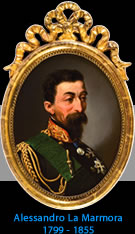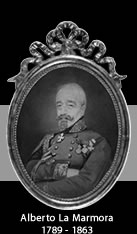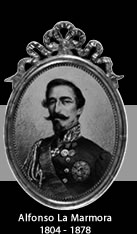| Alessandro La Marmora |
|
The perseverance the knowledge the loyalty the commitment to the State
Alessandro Ferrero della Marmora (1799-1855) Alessandro was born in Turin on 27 March 1799
In 1809, at the age of ten and thanks to the intervention of his mother, he became a page at the court of Prince Camillo Borghese, a position which, according to Emperor Napoleon, could only be attained by the sons of the most influential subalpine nobility. In 1814, at the age of fifteen, he joined the Piedmontese army as supernumerary second lieutenant in the regiment of the Grenadier Guards and became regular second lieutenant in 1815; that year he participated in the Grenoble campaign, taking the place of a flag-bearer, and was seriously wounded by an explosion of a gunpowder powder. In 1816 he was appointed second lieutenant of the Grenadiers and in1817 orderly lieutenant . In 1821 at the age of 22, he fought at Novara with the troops under the orders of General Sallier de la Tour and was awarded the cross of justice by the Mauritian Order. In 1831 he presented his first project for the creation of the Bersaglieri corps which was established by the king in 1836; in 1844 Alessandro was colonel in command of the Bersaglieri and took part in the First War of Independence which was the baptism of fire for the new military corps; on the bridge of Goito in 1848, when Alessandro was 49, he was shot in the face by a bullet which broke his jaw. In July of the same year he was promoted to major general. The following year, 1849, he was appointed Chief of Staff of the army and inspector of the Bersaglieri. For his participation in the battles of Mortara and Novara he received the silver medal for Military Valour. The same year he moved to Genoa where he was in charge of the division stationed in the Ligurian city and at the command of his brother Alfonso, Royal commissioner who had been sent to quell an anti-monarchy revolt. In 1852 Alessandro was regular commander of the military division of Genoa and in the same year was promoted by King Vittorio Emanuele II to lieutenant general. Alessandro stayed in the Ligurian capital until 1854, when he married Rosa Roccatagliata, widow of Rati Opizzoni. In 1855, at the age of 56, he was lieutenant general in command of the second division of the army corps sent to the Crimea, where his brother Alfonso was commander-in-chief of the contingent of the Kingdom of Sardinia in the East. The troops of Savoy, thanks to the diplomatic manoeuvres of Cavour, introduced by Alfonso la Marmora, joined the Turkish, British and French contingents against Russia. Two other members of the family accompanied the two brothers: Alfonso’s wife, Giovanna Bertie Mathew and nephew Vittorio, son of his brother Carlo Emanuele who was naval officer in command of the port of Balaklava. Alessandro and the Bersaglieri left Genoa for the Crimea on the 19 May in 1855 on the warship Costituzione which took ten days to reach Balaklava. In the following months a cholera epidemic spread rapidly among the Piedmontese troops and between the end of May and the beginning of June the number of deaths quadrupled. Alessandro la Marmora fell ill on June 4th and died on the night of 6th and 7th June on a camp bed at Kadikoi, just like any ordinary soldier. His body was buried not far from the camp but was later moved twice and finally placed in the naval cemetery of Balaklava where other commanders of the Crimean war were also buried. His remains were brought back to Italy in 1911 with great ceremony and laid to rest in Biella in the La Marmora crypt in the Basilica of San Sebastiano. His death from cholera had an ironical antecedent: Alessandro had written notes about how to treat and prevent this disease while he was commander of the Military division of Genoa and the epidemic was raging in the city. The Bersaglieri corps, founded by Alessandro la Marmora, was officially established by King Carlo Alberto on 18 June 1836. Alessandro had begun to work on the project to create a new military unit in 1831. Like his bother Alfonso, he had travelled all over Europe to study existing military corps and to learn what changes were required. Alessandro was chiefly inspired by the Chasseurs des Alpes, and wanted to build a military unit capable of moving quickly and in small groups over particularly difficult terrain. However, his idea was not accepted by the military hierarchy of his time who still relied on the strategic methods of the 1700’s. Until that time, war had been a head-on clash between armies which moved according to precise rituals and procedures dictated by rigid hierarchical schemes. Alessandro, with his Bersaglieri idea , broke with this centuries-old tradition, envisaging his Bersaglieri as the marines of today, a specialized assault corps, trained to fight in the most difficult terrain, intervening swiftly and with subtle manoeuvres. As can be seen from the biographical details events mentioned here, Alessandro devoted his life to the military cause and held no political or civilian offices. In 1821 at the age of 22 Alessandro La Marmora received the cross of the Mauritian Order for distinction in the battles of Novara. He was also awarded the Silver Medal for Military Valour for having fought at Novara and Mortara, the Piedmontese Medal of the Crimean War and he was made Knight of Honour and Devotion of the Sovereign Military Order of Malta. Of great importance in Alessandro’s life were his close relationships with his numerous brothers and sisters and in particular with the three brothers with whom he shared the army experience. In 1854 at the age of 55 and a year before he left for the Crimea where he was to die, Alessandro La Marmora married Rosa Roccagliata, widow of Rati Opizzoni, and whom he met in Genoa while he was recovering from a riding accident. The couple did not have children. Alessandro La Marmora’s life is a mixture of brilliance and misfortune. Unlike his brother generals who were also involved in politics and studies, he was a purely military man and had the satisfaction of seeing the realization of his project to reform the army and the creation of a new corps. But his life was peppered with serious and painful events : from his war injury in 1848 which followed other similar accidents and which was to leave him permanently disfigured, to his late marriage which was destined to be cut short by his death after only a year, leaving no heirs. Alessandro came to be known as “papa Sandrin”, the father of the Bersaglieri. Celebrations in memory of Alessandro began only a few years after his death when his brother Alfonso erected a bronze statue of him in the garden of the house he had built along what was to become the via Cernaia in Turin, on land which was awarded to him by the Chamber of Deputies for his war achievements . In 1858 the Bersaglieri barracks were constructed in the same area of the city and in 1886 the National Association of the Bersaglieri was founded. The many difficult times of his life both as man and soldier made him a popular figure , arousing feelings of affection and loyalty to the founder that still characterize the corps of the Bersaglieri and the National Association of the Bersaglieri today. The remains of Alessandro La Marmora were brought back to Italy with great ceremony in 1911 on the occasion of the celebrations for the foundation of the Bersaglieri and the 50th anniversary of the Unification of Italy. This event was one of the first “live” media operations of the age as it was followed step by step by all the means of communication available at that time. The triumph with which the founder of the Bersaglieri was welcomed became a fundamental element of the propaganda of the nationalistic war machine which was warming up in view of 1915. Thanks to this patriotic fervor the La Marmora crypt in the Basilica of San Sebastiano in Biella became for the first time a place where the public could commemorate national events . In the following years the Biellese section of the Bersaglieri assumed responsibility for guarding the tomb of the founder and organized a series of recurrent ceremonies such as the annual celebration which is held at Epiphany. The brothers Carlo Emanuele, Alberto and Alfonso are also buried in the La Marmora crypt in San Sebastiano in Biella. |













